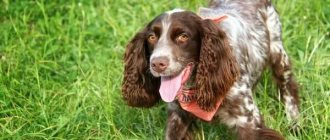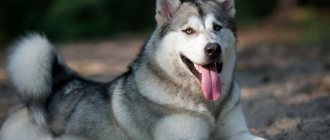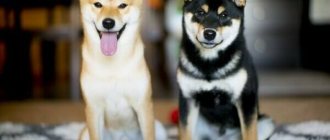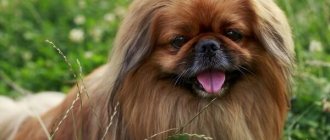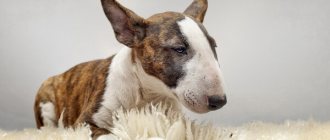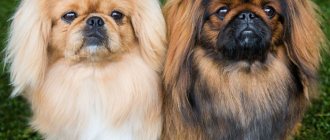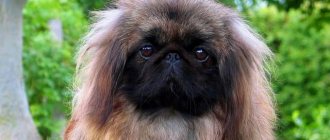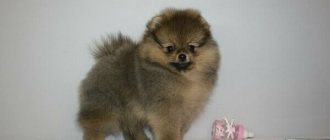It's not often you see a pure white husky.
Such dogs are highly valued among professional breeders and often become winners of exhibitions.
But the white husky is also incredibly good as a pet - it has a friendly and playful disposition.
His fur, sparkling in the sun's rays like freshly fallen snow, will invariably attract attention to such a pet on walks.
A white husky with brown or blue eyes will never go unnoticed at exhibitions - experts will definitely pay attention to a dog of this color and will probably appreciate it highly.
Origin story and what it looks like in the photo
White huskies owe their appearance to the harsh climate of the north of East Asia and to the tribes that in ancient times lived on the territory of modern Chukotka.
One day, when these people needed to move to new territories rich in game, they bred a strong, hardy and unpretentious dog, which later became known as the Chukchi sled dog.
Until now, representatives of this breed, already recognized by the RKF, continue to be bred in Chukotka.
It was from them that Siberian Huskies inherited a variety of colors, including white and coat colors derived from it.
Sled dogs were so popular in the north of the Far Eastern part of Russia and were bred by local tribes in such large numbers that in the old days these lands were called “the country of dogs.”.
In the 17th and 18th centuries, when the fur trade acquired particular importance for the Russian Empire, these territories began to be actively developed by pioneers, and, later, by the first settlers.
This contributed to the development of sled dog breeding, and for the first time the world learned about the existence of dogs that can be used to transport people or cargo.
In the early 20th century, sled dogs were introduced to Alaska, where they soon became popular as working dogs and racing dogs . The recognition of this breed became the beginning of exhibition breeding and contributed to the fact that the white color began to be highly valued.
Marriage or breed?
White coloring is considered acceptable for a husky, but only if it also has black or brown pigmentation.
Expert opinion
Kozhevin Semyon Kirillovich
Expert dog handler.
“The white color in this breed was not very popular before, since it was more difficult for mushers to see white dogs during a blizzard in the snow than animals with a darker color. Only the recognition of the Siberian Husky as a separate breed contributed to the fact that pure white dogs began to be in demand and highly valued. Currently, this coat color is still considered rare, and therefore such puppies, especially if they have blue eyes, can be quite expensive. However, it should be noted that the white husky will never go unnoticed: on the street, at a party, and even in the show rings, it will certainly be the center of attention.”
Dietary recommendations
Siberian Huskies happily eat both natural and commercial food. Dogs always have a good appetite. The body easily digests foods high in protein and fat.
If the dog eats natural food, then the basis of the diet should be meat. It is recommended to give preference to lamb and beef. Once a week, instead of a meat meal, they give fish. The Husky's diet must include:
- cereals;
- vegetables;
- eggs;
- low fat fermented milk products.
If dry industrial food is chosen as food, then it should not contain dyes, flavors or artificial preservatives. For feeding huskies, it is recommended to purchase premium and super premium food. Such ready-made food will provide the animal with all the necessary microelements and vitamins.
On a note!
Owners of white huskies claim that these dogs are the most prone to allergies. This situation is typical for many light breeds, but it is not dangerous. You just need to choose your diet more carefully.
Huskies are a wonderful active breed that is ideal for people leading an active lifestyle. With such owners, all the natural beauty of the animal will be revealed.
Character traits
The White Husky is a friendly, playful and cheerful dog who usually becomes very attached to his owners and simply adores children. These are excellent companion dogs, and white huskies can achieve excellent results in sports.
These dogs are characterized by such qualities as intelligence, intelligence and the ability to make decisions independently if the owner cannot do this for some reason .
Contrary to popular belief that huskies are difficult to train, they are excellent at learning new commands.
NOTE!
These dogs are characterized by such qualities as independence and independent disposition, which sometimes turn into self-will.
In addition, huskies have a tendency to run away and wander, and if they stay in an apartment all day, they can howl from boredom or chew furniture.
These dogs are as friendly to strangers as they are to their owners, which creates some difficulties when walking with them and makes them unsuitable as guards.
A white husky may be aggressive towards other animals, especially small rodents or birds, and try to grab them.
Advantages and disadvantages
pros:
- Beautiful and unusual appearance.
- Endurance and unpretentiousness.
- They can live both in rural areas and in city apartments.
- Friendly attitude towards people.
- Intelligence and intelligence.
- Ability to independently find solutions.
- Playfulness and love for children.
- Devotion to the owner.
- Uncomplicated daily grooming.
Minuses:
- Tendency to howl, making tunnels, running away and wandering.
- Staying in the apartment all day can damage furniture or other things.
- They need long active walks, as well as great physical activity.
- Very cunning and at the same time mischievous.
- Sometimes they are self-willed and stubborn.
- They can be aggressive towards small animals.
- They are overly trusting of strangers and are not suitable for the role of guard dogs.
Dimensions, weight and other distinctive features
| Options | Description |
| Dimensions | Males - 53.5-60 cm Bitches - 50.5-56 cm |
| Weight | Males - from 20.5 to 28 kg Bitches - from 15.5 to 23 kg |
| Body Format | Slightly stretched, but close to square: the length of the body exceeds the height at the withers by 1-3 cm. |
| Head | Wider in the forehead and somewhat narrower towards the muzzle. |
| Ears | Triangular, standing, medium in size. |
| Eyes | Set slightly obliquely, almond-shaped. Eye color can be brownish in various shades, as well as blue or light blue. Heterochromia is also considered acceptable. |
| Nose | The nose of white huskies can be black, brown or almost flesh-colored, and “snow” pigmentation is also possible. |
| Neck | Medium in length, not too massive, but at the same time strong and muscular. |
| Rib cage | Quite deep and wide. |
| Limbs | The front ones should be parallel, level, and moderately wide. The hind legs have well-developed muscles. |
| Tail | It is shaped like a fox's tail. When at rest, the husky keeps it lowered, but when excited, the tail rises above the back in the shape of a sickle. |
| Wool | Double layer, medium length. It consists of dense, harsh guard hairs that adhere to the body and soft, thick undercoat. |
Thoroughbred standard
The Siberian Husky breed standard specifies certain parameters . The slightest non-compliance with the standards leads to the disqualification of the individual from the competition.
Adult dog
An adult Husky is a medium-sized dog, lean, free-spirited and graceful in movement. The body is compact, well-furred, the tail is drooping. The length of the body from the shoulder to the ischial tuberosity is greater than the height of the animal at the withers. The head is triangular with erect ears, medium in size. The legs are slender and strong, high.
The general proportions of the body reflect the original task of the breed - transporting loads in sleds over long distances. An overly developed massive skeleton causes an awkward, heavy gait of the animal and lower scores when assessed by a professional jury.
Males are larger, but not coarse, without brutality in constitution . Females are smaller and lighter, but not slender. Bitches and males cope equally well with their direct task in the harsh conditions of the Far North.
Puppy
The final stage of formation of the dog’s appearance occurs by 2 years. But already from the moment of birth one can judge significant future changes. In conditions of good maintenance and proper nutrition, standard puppies meet certain requirements:
| Age, months | Weight, kg | Characteristic changes |
| Newborn | 0,5-0,6 | Actively voices, fights for a place at the nipple. |
| 1 | 3 | Daily increase in body weight, rounding of the tail. |
| 2 | 5,5-6,5 | Height 26-32 cm. |
| 3 | 11-12 | Height 38-43, transition to independent nutrition. |
| 4 | 13,5-14,5 | 45-49 cm. |
| 5 | 16,5-17 | 49-51 cm. |
| 6 | 20,5-21,5 | 51-53 cm. |
| 7-9 | 21-25 | 54-59 cm, teenage period. The moment of intense stretching of the limbs and torso in length. |
| 9-12 | 21-28 | 53-60 cm, the final formation of the overall appearance, stance and character. |
Important ! Over centuries of breeding, the digestive system of the breed is not adapted to the introduction of vegetable complementary foods (porridge).
The main diet of the animal consists of food predominantly containing protein.
Husky shades of white
- White . With this color, the dog should not have a single mark of a different color, but the nose, edges of the eyelids and lips must have black or brown pigmentation.
- Red and white . Against the main background of a reddish, fawn or copper shade, there is a subclass: lightening of the coat to white on the head, muzzle, neck, chest, lower part of the body, lower legs and tail.
- Brown and white . The main background is brown from dark copper to a shade of dark chocolate, with this color the dog also has a white undercoat.
- Gray-white . On the main color of any of the shades of gray, from light silver to graphite, there is a white undercoat, and, often, markings in the form of a mask or glasses on the face and forehead.
- Black and white . On a black background there is a white undercoat and, often, markings on the face and forehead in the form of a mask and glasses or a trefoil.
- Piebald . Markings of red, grey, brown or black are scattered on the main white background.
- Splash . This color looks as if a black, grey, red or brown mantle had been thrown over a white dog. Typically, a husky with this coloring has a white collar, as well as a blaze on the forehead and muzzle.
- Isabella . The tips of the white coat are darkened to a cream or pale red tint.
- Silver . The tips of the white hairs are darkened to gray or silver.
The breed standard does not prohibit merle coloring in huskies, however, not all experts recognize it, believing that such a coat color is atypical for sled dogs.
Common, but no less beloved
Another transitional stage between white and black is gray wool, which looks no less impressive than all other options. Although this coloring is not considered rare for dogs representing the Husky breed, there are still hunters for it.
The undercoat is mainly silver, tinged with beige and cream. The wool itself is traditionally grey. Regarding the contours around the eyes and the coloring of the nose, these parts can be exclusively black.
Life expectancy and what diseases are they susceptible to?
The average lifespan of white huskies is 12-15 years, and they may be predisposed to the following diseases :
- Degenerative myelopathy.
- Glaucoma.
- Cataract.
- Eversion or inversion of the eyelid.
- Dermatitis.
- Cardiovascular diseases.
- Diseases of the genitourinary area, more common in males than in females.
- Respiratory diseases that can develop in racing dogs.
White Huskies can also be susceptible to food allergies, and most often, they develop them due to improperly selected food..
Basic rules of care
The coat of such a pet needs to be combed twice a week, and during shedding - daily, trying to remove the falling out undercoat as best as possible.
There is often no need to bathe white huskies, since they are neat animals, and their coat has the ability to self-clean . Therefore, it will be enough to bathe your pet 2-3 times a year.
The dog's ears should be inspected and, if dirty, cleaned with cotton swabs. Eyes are cleaned with cotton pads soaked in a special eye cleanser.
IMPORTANT!
To keep your dog's teeth in good condition, he must chew on cartilage or treats intended for cleaning his teeth.
The nails of white huskies are trimmed infrequently: only if they do not grind down on their own during walks . When shortening them, you should use nail clippers, not scissors or nail clippers.
Do colors change with age?
The color of an adult husky is difficult to predict. The fact is that during the first moults (at 6-10 months) juniors “rebloom” and change color. Whether the original color will remain the same, deepen or become more faded is impossible to predict.
For example, a copper puppy may turn red, while a bright red puppy may turn fawn. The “glasses” that give the look charm may also disappear.
Typically, the color of a husky changes slightly with age: the color fades and becomes less saturated.
What do the puppies look like?
Many puppies have blue eyes , however, later they can change the color to amber or even brown .
The ears of babies of this breed are usually fully or partially raised by the time of sale, the hair is softer than that of adult dogs, but not too long and not fluffy.
In general, such a puppy is somewhat similar to a snow-white fox, the similarity with which is enhanced even more due to the fact that its gaze expresses curiosity, interest and playfulness.
White Husky puppies must have brown or black pigmentation, without which the dog will be considered an albino.
Different iris color
The breed standard is not limited to just the blue tint of the iris. You can often find Huskies with deep brown or black looks. As a rule, such individuals have a more saturated coat color, for example, black with splashes of white. Huskies with warm brown coats often have reddish-amber eyes. Sometimes there are representatives of the breed with olive-colored eyes.
Despite the fact that many strive to become the owner of a dog with blue eyes, brown-eyed individuals are considered more practical. The sky-hued iris is more sensitive to light. In conditions of frequent and heavy snowfalls, you can notice that blue-eyed huskies are constantly squinting their eyes. In addition, it is believed that individuals with a dark look are more resistant to disease.
How to choose?
You should purchase such a pet only with documents, since otherwise you can buy not a purebred husky, but a mixed breed.
When choosing a baby, you need to pay attention to his appearance and behavior . A good white husky puppy looks active and healthy, has no rashes on his skin, and his eyes, ears and nose are clear.
The baby should look well-fed, but at the same time harmoniously built.
It is not necessary for a pure white puppy to come from parents of the same color, however, there must be white dogs among its ancestors in its pedigree.
